Improving management of banana pests and diseases
Bananas are susceptible to a wide range of pests and diseases. Some of these pests and diseases are highly destructive and very contagious (easily spread), and once introduced they are persistent and difficult to eradicate. In general, the severity and occurrence of pest outbreaks and plant damage depends on the prevailing environmental conditions, specific banana cultivars, and the specific disease or pest. However, most of these can be managed and controlled by implementing organic production practices.
The main approach in organic pest and disease management in banana production is prevention and proper management of infections to restrict spread and multiplication. With proper implementation of cultural practices (e.g. soil fertility improvement, crop rotation, use of resistant varieties and clean planting materials, proper sanitation in the field and rouging of infected plants) many of these pests and diseases can be effectively managed. This is also necessary because most the destructive diseases cannot be eradicated by direct control methods.
Discussion on local management of common banana pests and diseases
Try to find out the most problematic pests and diseases in the area asking the following questions:
- Which banana pests and diseases are common in the area?
- How do you prevent the introduction or spread of these pests or diseases?
- What do you do when an infection is identified in the banana plantation?
Establishing a new banana garden
A site with deep, well-drained and fertile soils, preferably rich in organic matter is good for banana production. It will encourage the development of strong plants that can tolerate infections. A newly opened land without signs or history of nematodes or the devastating Fusarium wilt and bacterial wilt diseases is preferred.
If the site has been used for production of bananas in the last two years, it is highly recommended to remove all remaining banana plants and corms. Normally such remnants harbour a lot of pests and diseases. The remnants should be transferred into another field (not of bananas), chopped and spread to dry or composted. The land should then be planted with a legume crop (like beans) or left to fallow with a legume green manure cover crop for 1 to 2 years. This will ensure that any remaining pest or disease infections are completely removed before introducing new banana plants.
All perennial weeds should also be removed and destroyed before planting because bananas are very susceptible to weed competition. Some of the existing trees at the selected site should be left during land clearing in order to protect the young banana plants from wind and strong direct sunshine.
Selection and preparation of planting material
Proper management of banana pests and diseases starts with the careful selection and handling of pest and disease free and, where possible, resistant planting materials. The right cultivars and varieties should be selected with respect to the disease problems prevalent in a given location. Some cultivars are resistant to certain diseases like Cavendish and highland cooking bananas, and varieties like FHIA 17 (Cavendish variety), FHIA 23 (Gros Michel variety) are resistant to the devastating Fusarium wilt (Panama) disease. Clean planting materials of superior banana cultivars that are resistant to diseases exist, and can be obtained through local extension officers, research stations or nursery operators (banana tissue culture hardening nurseries). It is highly advisable to plant different cultivars and/or varieties in the banana plantation. In case a variety or cultivar is attacked by certain pests or diseases, then the whole field will not be wiped out.
Bananas are propagated using suckers or corms from the mother plant. Generally, well treated suckers/corms or tissue culture banana plantlets are highly recommended because they are free of pests and diseases. Suckers for planting should be carefully selected and prepared to minimise spread of pests and diseases. They must be obtained from pest and disease free plantations. Sword suckers are preferred because they are usually less infected with nematodes and weevils than bigger suckers.
Recommendations to farmers for preparing planting seedlings:
Planting materials should be prepared in the field from where they are being obtained to limit the transfer of infections into new fields.
- Remove all leaves, outer leaf sheaths, roots, dead parts of the plant and pare the corm (trim off part of the corm) to eliminate weevils, weevil eggs and nematodes. Any brown and black spots that may appear on the corms should also be removed until only white corm tissue remains.
- It is recommended to treat the suckers in order to clean them of any infections. This is done by soaking the suckers in soapy water over night to eliminate weevil eggs and nymphs. Alternatively, the suckers can be treated by soaking the base of the plant in hot water (about 60 °C) for 10 minutes. This will kill all nematodes in the outer layers of the sucker. A 10 % household bleach solution (100 ml of solution in 1 litre of water) is also useful for disinfesting corms. Submerge the base of the suckers into the solution for about 20 minutes.
Treated suckers should be planted within one week to avoid being reinfected.
Recommendations to farmers for planting a banana garden:
- Mark out rows - with a spacing of 3 m by 3 m (10 f x 10 f) to get the proper plant population of 450 plants per acre. This helps to avoid competition between banana plants and limits spread of pests and diseases from one plant to another.
- Dig out planting holes - 60 cm by 60 cm by 60 cm (2 f x 2 f x 2 f) while placing the top soil and subsoil on separate sides of the planting hole. This ensures that during planting, the top soil mixed with manure/compost will be used for refilling the hole.
- Plant bananas at the beginning of the rainy season - so that newly planted plants receive enough water for quick establishment. When planting, do not completely fill the planting hole. Leave a shallow basin of about 1 foot to enhance harvesting water for the young plant. Later during growth, this also provides a conducive environment for producing new suckers away from the mother plant.
Discussion on preparation of planting materials
Inquire how farmers obtain planting materials for new gardens by asking the following questions:
- How do you prepare banana planting materials for establishing new banana plantations?
- How do you proceed to establish a new banana garden?
Discuss the approaches together while noting any shortcomings and then introduce the guidelines below.
Routine management practices
Some management practices are helpful in both strengthening the growing banana plants and in minimising the spread of pests and diseases. However, these practices need to be routinely applied together as a package because, leaving one practice may undermine the benefits achieved from the others.
a. De-suckering
Competition between suckers depletes soil fertility very fast and results in weak plants which are very susceptible to infections. About 3 to 4 suckers should be maintained per stool in order to ensure strong plants and good yields. Any extra suckers should be removed when they are still young. Suckers at different growth stages (mother, daughter and granddaughter) on the opposite side of the mother plant, should be chosen, also to avoid competition for light. De-suckering should be done well, so that pruned suckers do not grow up again. The sucker pseudostem should be cut off near its corm and the sharp point of the knife twisted into the growing point to kill off the sucker permanently. During this ope-
ration, care must be taken not to harm other daughter plants.
In the course of time, the banana plants tend to grow away from the original space whereby the gaps between the plants become smaller. At this point, it is necessary to remove the plants that stand close to each other. If the original pattern of the banana plantation becomes completely distorted, then the plantation should be cleared and newly planted.
b. Deleafing
Old leaves and sheaths are susceptible to infections and can host infections if not removed in time. Removal of old leaves helps in management of the Sigatoka leaf spots, limiting its spread to young leaves and plants, while the removal of old sheaths eliminates hiding places for adult banana weevils. In addition, old leaves that hang downwards shield the young plants from sunlight. It is therefore recommended to remove all old leaves and sheaths that have attained natural senescence and use them as mulch.
It is, however, important that enough leaves are left on the plant to produce a good quality bunch. The average number of leaves per banana plant should be 8 to 10 leaves at flowering and 4 at harvest. Complete deleafing of the plant prior to harvesting is not recommended as this starts the ripening process, before the plant is actually ready.
c. Cutting off male buds
Removing the male buds early also helps reduce the spread of diseases like the banana bacterial wilt, which can be transmitted by bees collecting nectar from the banana male buds. Care should be taken not to damage the hands of the bunch while removing the male buds. Male bud removal also encourages quicker development of the young bunch.
Management of specific pests and diseases
Banana weevils and nematodes are the most important pests of bananas, attacking nearly all banana cultivars. On the other hand, banana has a multitude of diseases which can cause significant yield losses if not well managed. For example, the black sigatoka, bunchy top disease, streak virus disease, and the highly devastative bacterial wilt and Fusarium wilt (panama) diseases.
Discussion: Working groups on field identification of banana pests and diseases
Organise a field visit with the participants to different banana fields and identify any observable signs of pest or disease problems. Ask the farmers to analyze the signs of infection and identify the pests or diseases.
Pest management
a. Banana weevil (Cosmopolites sordidus)
The Banana weevil is a very damaging banana root borer. The larvae bore into corms, suckers, and roots and lead to extensive root destruction. This leads to stunted plant growth and eventually premature toppling of the plants and plant death.
Recommendations to farmers for management of the banana weevil:
- Use clean planting materials - As mentioned earlier, use tissue culture plantlets or treated suckers for planting new banana plantations.
- Crop rotation - In heavily infested gardens, it is highly recommended to progressively destroy the entire garden and remove all banana plants and their corms. Chop them to dry or compost them and plant other crops in the field for 1 to 2 years. Make sure that all corms and roots are destroyed during that time.
- Ensure field hygiene - It is a common practice to split the pseudostem after every harvest. The stem is split open and the sheaths are spread out to dry so that weevil eggs and larvae are destroyed. The sheaths should, however, be laid about 2 feet away from the banana stool, like any other mulching material in a banana plantation. Do not move banana residue material (pseudostems, corms, sheaths) from one field to another in order to limit transmission of weevils.
- Trap the weevils - Laying traps to catch banana weevils and killing the weevils collected from traps can be an effective method of controlling weevils especially in small gardens. The weevils are mobile at night and can be trapped by baiting the field with slices of banana pseudostems. Traps should be cleared every 3 days so that they do not become a breeding ground for the weevils. All trapped weevils should be picked from the baits and destroyed or fed to poultry.
- Keep the banana stool clean - Mulching materials or any debris should not be put close or within the stool in order to deny weevils a hiding place. Also, any banana plant remains from infected gardens should not be used as mulch in clean banana gardens.
- Use natural pesticides - Such as wood ash, tephrosia leaf dust, chilli preparations with animal urine, tithonia leaf extract, and neem oil. These materials should be applied at the base of the plants around the stool and around infected pseudostems. However, it is important for certified organic farmers to check with their certification body before using any factory-made products for weevil control.
b. Nematodes
Radopholus similis and Pratylenchus goodeyi are the most damaging nematode species on bananas. Nematodes are microscopic (not visible with the naked eye) pests, which feed on banana roots. They destroy the roots and reduce uptake of water and nutrients. With damage to the roots, plants will lose stability and topple down. It is, however, hard for farmers to distinguish between damage caused by the nematodes and the banana weevils. Nematode attack will cause the plant to topple down with all the roots exposed (the whole plant is uprooted) while weevils will cause the plant to break from the base at the soil level. New fields become infested with nematodes when suckers from infected fields are used; nearly all suckers will be infected with nematodes in an infected field. Cooking bananas and plantains are particularly susceptible to nematodes.
Recommendations to farmers for management of the banana nematodes:
- Use clean planting materials - Use tissue materials or treat banana suckers to ensure that no infections are introduced into the new fields.
- Crop rotation - In heavily infested plantations, it is highly recommended to destroy the garden and remove all banana plants and their corms. Chop them to dry or compost them. Nematodes will survive in the soil for about one year if deprived of host materials. Therefore, after uprooting all banana material from the infected plot; grow other crops for a period for 1.5 to 2 years, followed by recultivation with clean banana planting materials.
- Increase soil fertility - Addition of compost in planting holes, top-dressing with organic manures and mulching with organic materials increases soil life activity and has a negative effect on soil pests like nematodes. It encourages establishment of stronger plants that are less susceptible to toppling as a result of nematode infestation.
- Field hygiene - Besides planting materials, nematodes can also be spread through soil carried on farm tools, farmers shoes/feet and banana residues, mainly corms. Therefore, ensure that proper cleaning is done of all tools and farmers shoes/feet before entering a healthy garden. Banana corms should not be shared between gardens to limit the spread of nematode infections.
Disease management
a. Bacterial wilt
Bacterial wilt is the most destructive banana disease, attacking all types of bananas. It is caused by Xanthomonas campestris pv. Musacearum. Infected plants show premature ripening and staining of fruits, yellowing of leaves, the male bud dries prematurely and a pus-like liquid flows when the stem is cut. The infection is spread when farm tools and infected plant parts are moved from infected to healthy gardens. It is also spread by pollinating bees visiting male buds of infected plants and passing the infection to male buds of healthy plants.
In order to effectively manage the bacterial wilt disease, participatory and community action is normally necessary. Local leaders, NGOs, extension and research staff can be very helpful in mobilising communities to implement strict quarantine practices. For example, restricting movement of planting materials and removal of male buds as soon as the bunch is formed.
Recommendations to farmers for management of the banana bacterial wilt:
The disease can also be managed by employing the following measures:
- Destroy all plants showing symptoms of bacterial wilt - at the very first show of any signs. Cut the entire plant and heap to rot or bury, to limit the spread of the disease. All tools must be disinfected by flaming them over fire or by cleaning them with Sodium hypochlorite or any other bleach solution.
- Use clean planting materials - Use tissue materials or treat banana suckers to ensure that no infections are introduced into the new fields.
- Crop rotation - After uprooting all banana material from the infected plot; grow other crops for a period of at least 2 years, followed by recultivation with pest-free banana planting materials.
b. Fusarium wilt
Fusarium wilt is caused by the soil borne fungus, Fusarium oxysporum f.sp cubense (Foc). It spreads mostly through infected suckers, soil attached to plants, tools and shoes/feet. As the disease disrupts the plant’s water vessels, leaves become yellow progressing from old to young leaves. The leaves then collapse at the petiole forming a skirt around the plant. Vascular tissues (pseudostems, corm leaf stalks), will also show discoloration to yellow, pale and dark red lines (i.e. infected vessels). Gros Michel and apple bananas are highly susceptible to Fusarium wilt. The fungus can survive in the soil for many years (up to 30 years) and is thus very difficult to control. Fusarium wilt can be distinguished from Bacterial wilt by the absence of symptoms in young suckers of less than 4 to 5 months of age.
Recommendations to farmers on management of the banana Fusarium wilt:
- Use resistant cultivars or varieties - This is the most cost-effective and sustainable method of controlling the Fusarium wilt in the field. Resistant varieties include: Cavendish, FHIA 17, FHIA 23 and other hybrids.
- Field hygiene - It is highly recommended to destroy infected gardens; remove all banana plants and their corms. Chop them to dry or compost them to limit the spread of infection. Plant the field with other non-susceptible banana cultivars (cooking bananas, Cavendish, or other hybrids). Select new clean fields for replanting with clean banana planting materials. Ensure that proper cleaning is done of all tools and farmers shoes/feet (dipping in a 10 % Sodium hypochlorite solution) before entering a healthy garden. Banana corms should not be shared between gardens to limit the spread of nematode infections.
c. Black sigatoka
Black sigatoka is also called Black leaf streak (caused by fungus Mycosphaerella fijiensis). It is the most important leaf disease that reduces yields. The disease causes severe discolouration and leaf necrosis, reducing the effective photosynthetic area dramatically and leading to poor fruit formation and small fingers. As the pathogen can be spread by wind or water, it becomes difficult to control.
Recommendations to farmers for management of the Sigatoka leaf spots:
Sigatoka leaf spots can be managed by applying the following cultural practices in order to improve host resistance and minimize the spread of infection:
- Improve soil fertility - Enhancing plant nutrition has been found to reduce leaf spot impact. A fertile soil encourages quick growth of the banana plant before significant leaf tissue is destroyed by the pathogen.
- Maintain proper spacing - As banana trees grow and produce suckers, there is a possibility of the space between neighbouring plants to reduce. It is important for the farmer to regulate the space between plants such that plant leaves from adjacent plants do not touch and rub against each other. This will limit the spread of sigatoka leaf spots.
- Ensure field hygiene - Remove old leaves and mulch them in non-banana gardens to limit infecting young leaves and plants and banana leaves and stalks should not be shared between gardens to limit spread of infections.
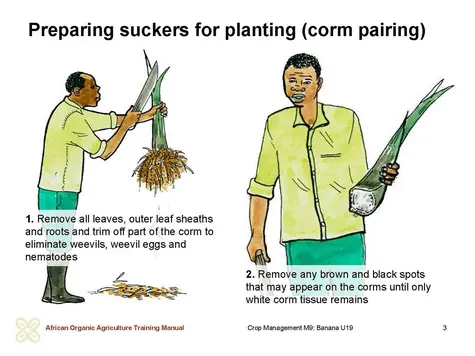
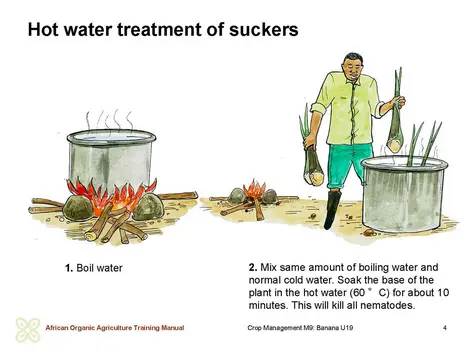
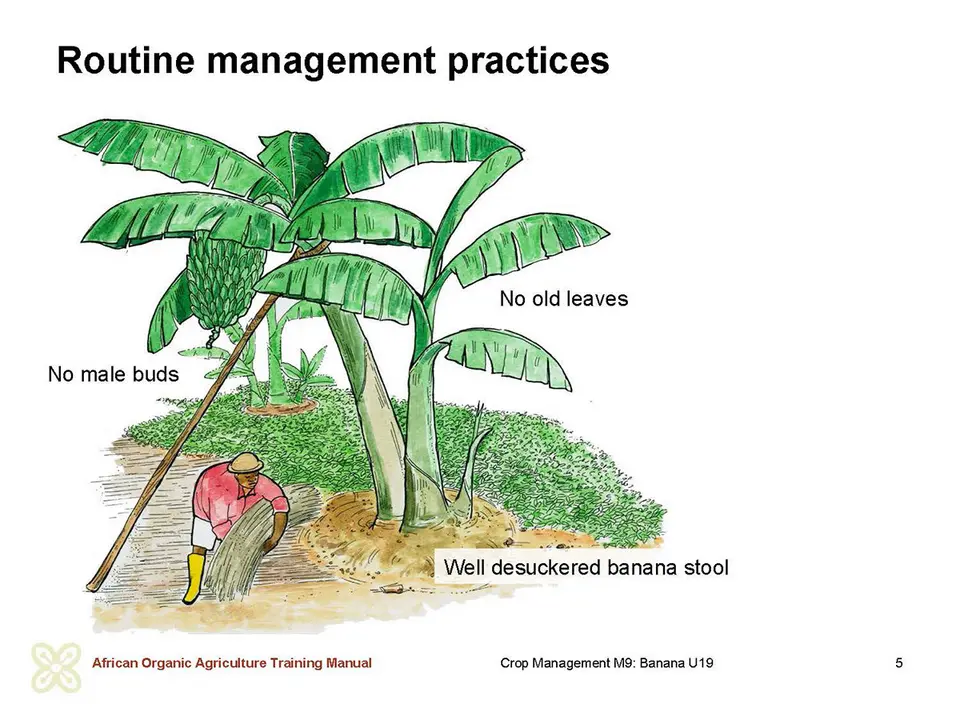
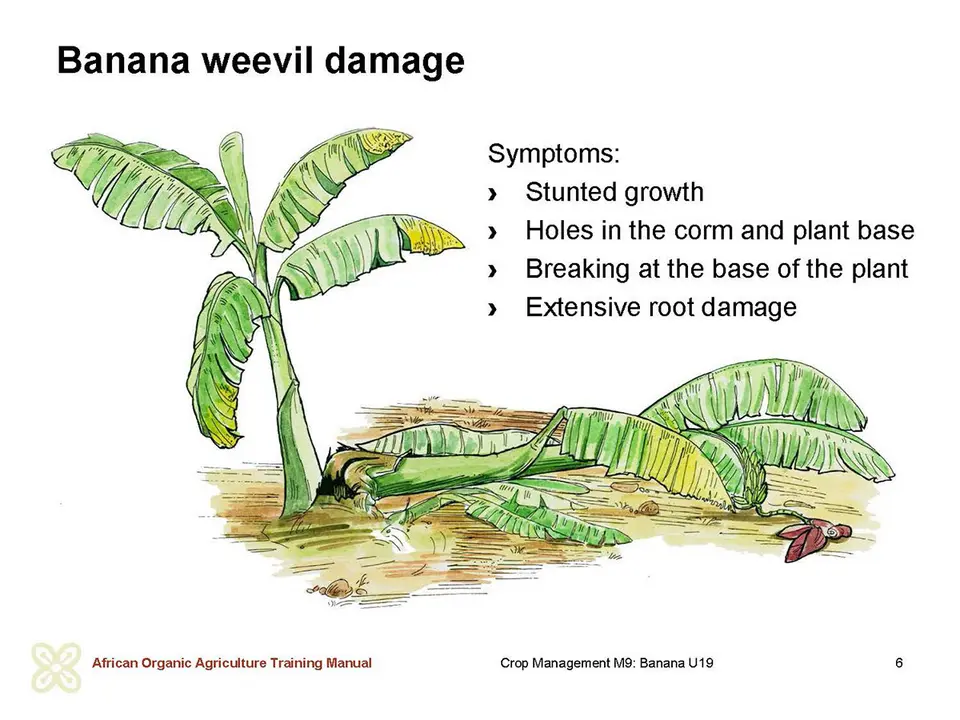
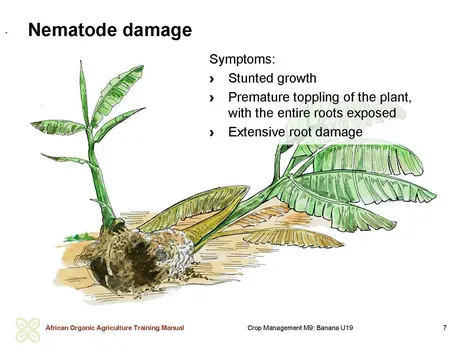
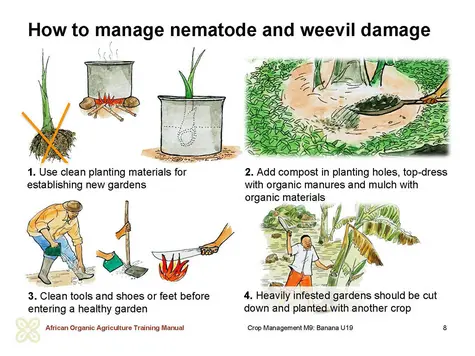
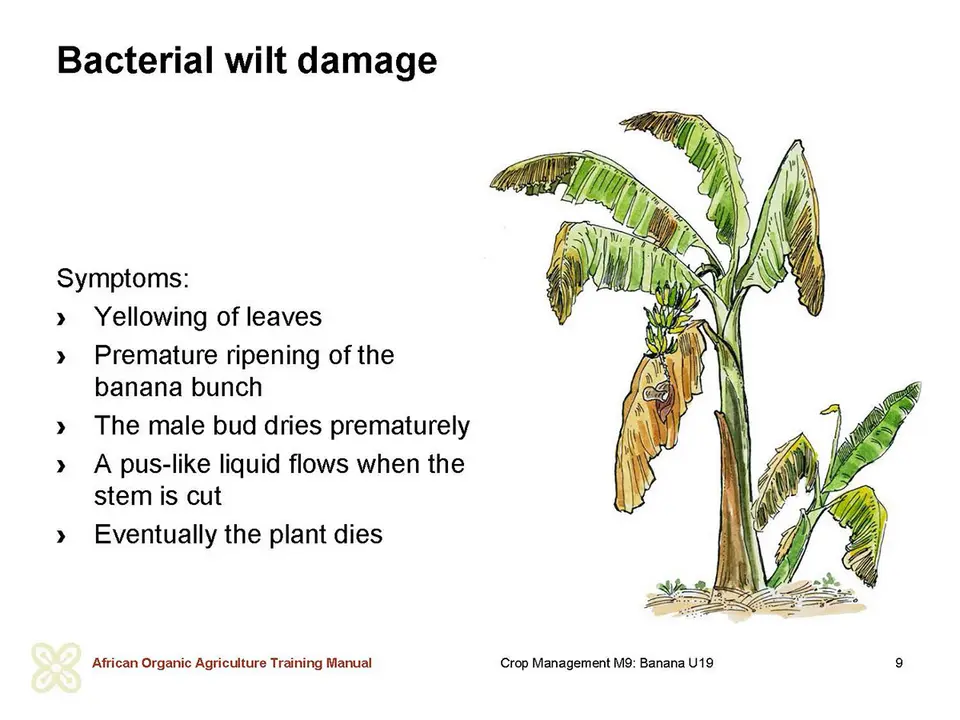
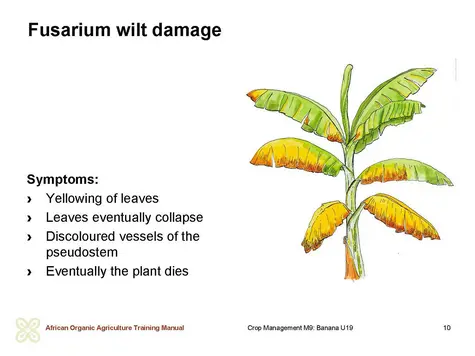
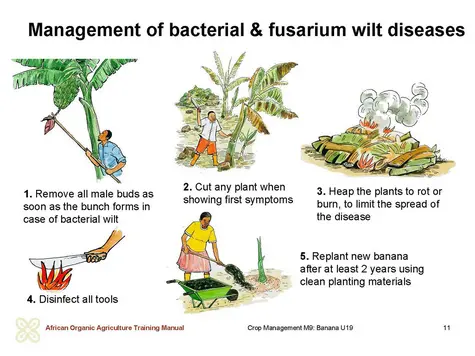
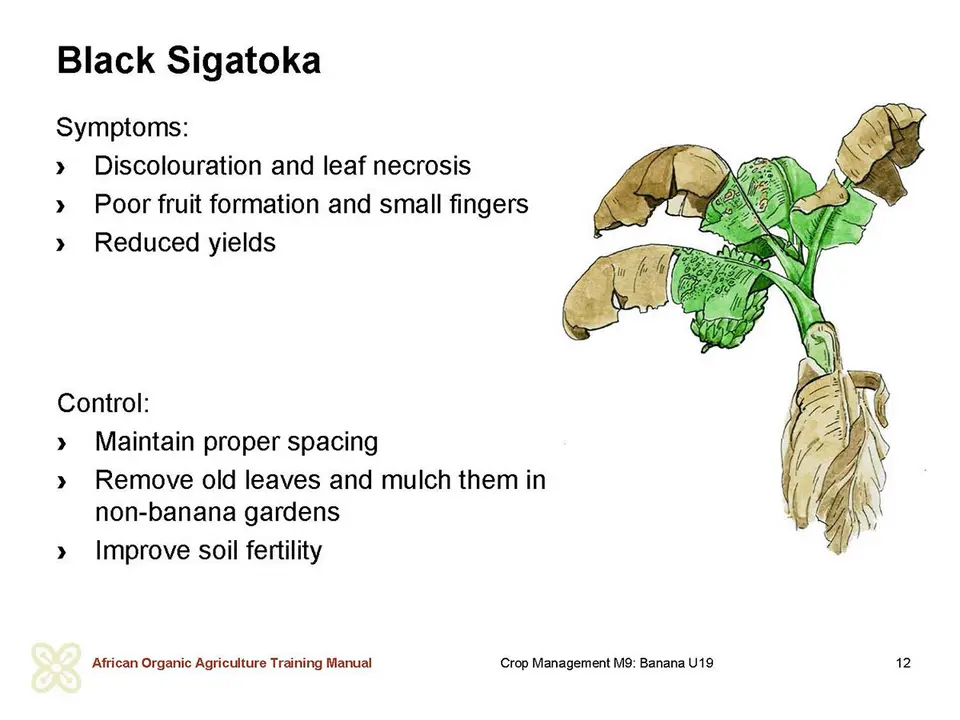
 tap and then scroll down to the Add to Home Screen command.
tap and then scroll down to the Add to Home Screen command.